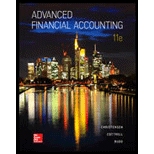
Concept explainers
a. Calculate change in book value of parent equity as a result of repurchase
Sale of shares subsidiary’s to non-affiliate:when subsidiary sells shares to a party outside the economic entity increases total
The amount assigned to non-controlling interest and controlling interest is also affected by two factors 1. The number of shares sold to non-affiliates and 2. The price at which the shares are sold to non-affiliates.
Requirement 1
Computation of change in the book value of shares held by P as a result of S issuance of additional shares.
b. Journal entry to recognize the change in equity book value
Sale of shares subsidiary’s to non-affiliate: when subsidiary sells shares to a party outside the economic entity increases total stockholders’ equity of the consolidated entity by the amount received by the subsidiary from sale. Such as sale increases the subsidiary’s total shares outstanding and reduces the percentage ownership held by the parent company.
The amount assigned to non-controlling interest and controlling interest is also affected by two factors 1. The number of shares sold to non-affiliates and 2. The price at which the shares are sold to non-affiliates.
Requirement 2
The entry to be recorded by P advertising to recognize the change in book value of the shares held.
c. Consolidation entries
Sale of shares subsidiary’s to non-affiliate: when subsidiary sells shares to a party outside the economic entity increases total stockholders’ equity of the consolidated entity by the amount received by the subsidiary from sale. Such as sale increases the subsidiary’s total shares outstanding and reduces the percentage ownership held by the parent company.
The amount assigned to non-controlling interest and controlling interest is also affected by two factors 1. The number of shares sold to non-affiliates and 2. The price at which the shares are sold to non-affiliates.
Requirement 3
The preparation of consolidation entries immediately following the issuance of additional shares
Want to see the full answer?
Check out a sample textbook solution
Chapter 9 Solutions
Advanced Financial Accounting
- Can you help me solve this general accounting problem using the correct accounting process?arrow_forwardI am searching for the correct answer to this general accounting problem with proper accounting rules.arrow_forwardPlease show me the correct approach to solving this financial accounting question with proper techniques.arrow_forward
- I am looking for the correct answer to this financial accounting question with appropriate explanations.arrow_forwardCan you solve this general accounting problem using appropriate accounting principles?arrow_forwardI am looking for the correct answer to this general accounting question with appropriate explanations.arrow_forward

 AccountingAccountingISBN:9781337272094Author:WARREN, Carl S., Reeve, James M., Duchac, Jonathan E.Publisher:Cengage Learning,
AccountingAccountingISBN:9781337272094Author:WARREN, Carl S., Reeve, James M., Duchac, Jonathan E.Publisher:Cengage Learning, Accounting Information SystemsAccountingISBN:9781337619202Author:Hall, James A.Publisher:Cengage Learning,
Accounting Information SystemsAccountingISBN:9781337619202Author:Hall, James A.Publisher:Cengage Learning, Horngren's Cost Accounting: A Managerial Emphasis...AccountingISBN:9780134475585Author:Srikant M. Datar, Madhav V. RajanPublisher:PEARSON
Horngren's Cost Accounting: A Managerial Emphasis...AccountingISBN:9780134475585Author:Srikant M. Datar, Madhav V. RajanPublisher:PEARSON Intermediate AccountingAccountingISBN:9781259722660Author:J. David Spiceland, Mark W. Nelson, Wayne M ThomasPublisher:McGraw-Hill Education
Intermediate AccountingAccountingISBN:9781259722660Author:J. David Spiceland, Mark W. Nelson, Wayne M ThomasPublisher:McGraw-Hill Education Financial and Managerial AccountingAccountingISBN:9781259726705Author:John J Wild, Ken W. Shaw, Barbara Chiappetta Fundamental Accounting PrinciplesPublisher:McGraw-Hill Education
Financial and Managerial AccountingAccountingISBN:9781259726705Author:John J Wild, Ken W. Shaw, Barbara Chiappetta Fundamental Accounting PrinciplesPublisher:McGraw-Hill Education





